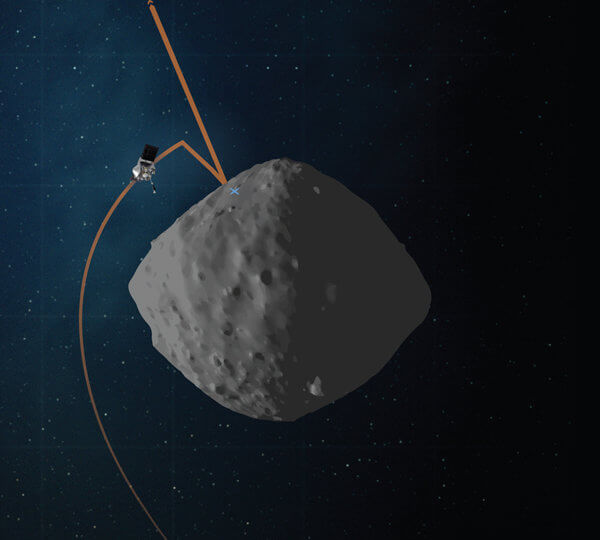NASA’s first asteroid sampling spacecraft is making final preparations for surface sampling on asteroid Bennu. Next week, the OSIRIS-REx mission will conduct a second test of the landing sequence, performing a final pre-landing activity at Bennu this fall.
On August 11, the mission will perform the “Matchpoint” test, the second practice test of the Touch-and-Go (TAG) sampling event. The test will be similar to the “Checkpoint” test on April 14, which performed the first two descent maneuvers, but this time the ship will add a third maneuver, called Matchpoint burn, and fly even closer to the site. Nightingale, reaching a height of about 131 feet (40 m) before moving away from the asteroid.
This second test will be the first time the spacecraft will perform the Matchpoint maneuver and fly in parallel with the Bennu rotation. The test also gives the team the opportunity to familiarize themselves with the spacecraft’s navigation in all descent maneuvers, while at the same time confirming the imagery, navigation and tracking systems of the spacecraft operate as expected during the event.
During the descent, the spacecraft pulls its propellers three times to reach the surface of the asteroid. The spacecraft will travel at an average speed of around 0.2 mph (0.3 km / h) for approximately four hours of excursion. The Matchpoint test begins with OSIRIS-REx firing its propellers out of its 800m (870m) safe orbit. The spacecraft then extends the robotic sampling arm, the Touch-And-Go (TAGSAM) Sampling Mechanism, from its stowed and parked position to the sampling setup. Shortly thereafter, the spacecraft spins to begin collecting navigation imagery for the Natural Feature Tracking (NFT) guidance system. NFT allows OSIRIS-REx to navigate autonomously on Bennu’s surface by comparing a list of onboard images with real-time navigation images taken during landing. As the spacecraft nears the surface, the NFT system updates the spacecraft’s predicted point of contact based on the position of the OSIRIS-REx relative to Bennu’s landmarks.
The spacecraft’s two solar panels move in a “Y-wing” configuration that places them safely above and away from the asteroid’s surface. This setup also places the spacecraft’s center of gravity above the head of the TAGSAM manifold, which is the only part of the spacecraft that will come in contact with Bennu’s surface when collecting samples.
When the OSIRIS-REx reaches an altitude of about 410 feet (125 m), it burns a checkpoint and descends steeper to Bennu’s surface for another eight minutes. About 164 feet (50 m) above the asteroid, the spacecraft fires its propellers for the third time to burn Matchpoint. This maneuver slows the spacecraft’s rate of descent and adjusts its trajectory to match Bennu’s rotation as the spacecraft makes final corrections to aim for the landing point. OSIRIS-REx will continue to display Bennu milestones for the NFT system to update the spacecraft heading for an additional three minutes of descent. This brings OSIRIS-REx to its target destination about 131 feet (40 m) from Bennu, the closest it has ever been to the asteroid. At the end of the tests, the spacecraft backs up, returns the solar panels to their original position, and returns the TAGSAM arm to the park position.
During testing, the one-way fire travel time for signals between Earth and the spacecraft will be approximately 16 minutes, preventing live control of ground flight activities. Then, before starting the test, the OSIRIS-REx team will associate all event commands with the spacecraft, allowing OSIRIS-REx to perform the test sequence autonomously after the GO command. Additionally, during the event, the spacecraft’s low gain antenna will be the only antenna pointing to Earth, transmitting data at a very low rate of 40 bits per second. Thus, while the OSIRIS-REx team will be able to monitor the vital signs of the spacecraft, the images and scientific data collected during the event will not be transferred until the test is complete. The team will experience the same conditions during the real.
Read latest Trending Update News.
On October 20, the spacecraft will fly to the asteroid’s surface on its first attempt to collect samples. During this event, the OSIRIS-REx sampling mechanism will touch Bennu’s surface for approximately five seconds, ignite a charge of pressurized nitrogen to disrupt the surface, and collect a sample before the spacecraft withdraws. The spacecraft is expected to return the sample to Earth on September 24, 2023.
NASA’s Goddard Flight Center in Greenbelt, Maryland, provides general mission management, systems engineering, and mission assurance and security for OSIRIS-REx. Dante Lauretta of the University of Arizona, Tucson is the principal investigator, and the University of Arizona is also leading the research team and plans to observe and scientifically process the mission data. The Lockheed Martin Space in Denver created the spacecraft and provides flight operations. Goddard and KinetX Aerospace are responsible for navigation in the OSIRIS-REx spacecraft. OSIRIS-REx is the third mission in NASA’s New Frontier program, which operates NASA’s Marshall Space Flight Center in Huntsville, Alabama, for the agency’s science mission in Washington.













